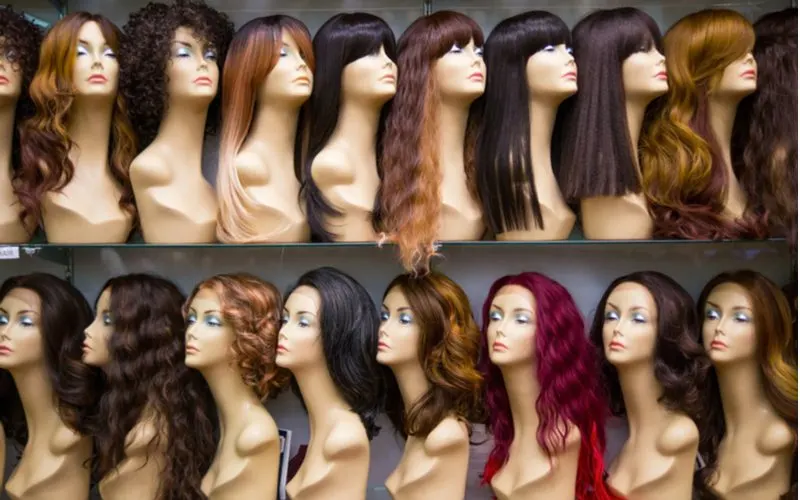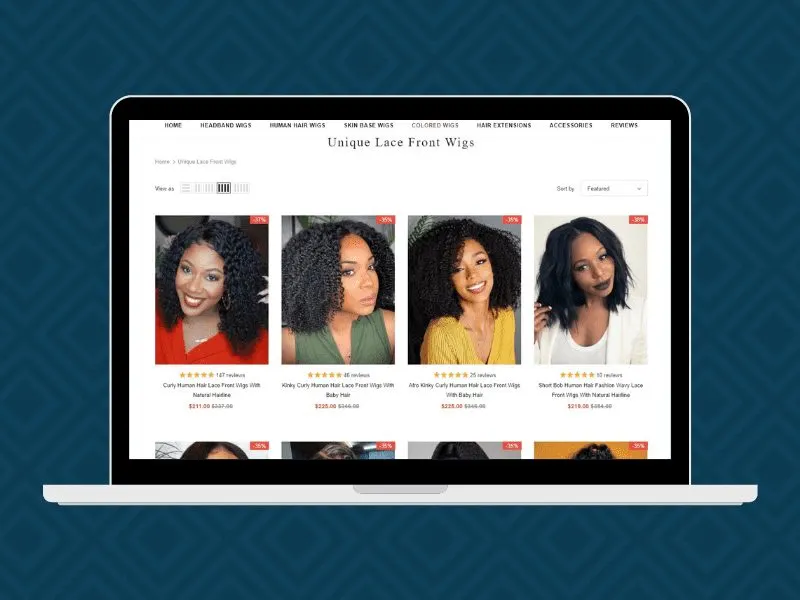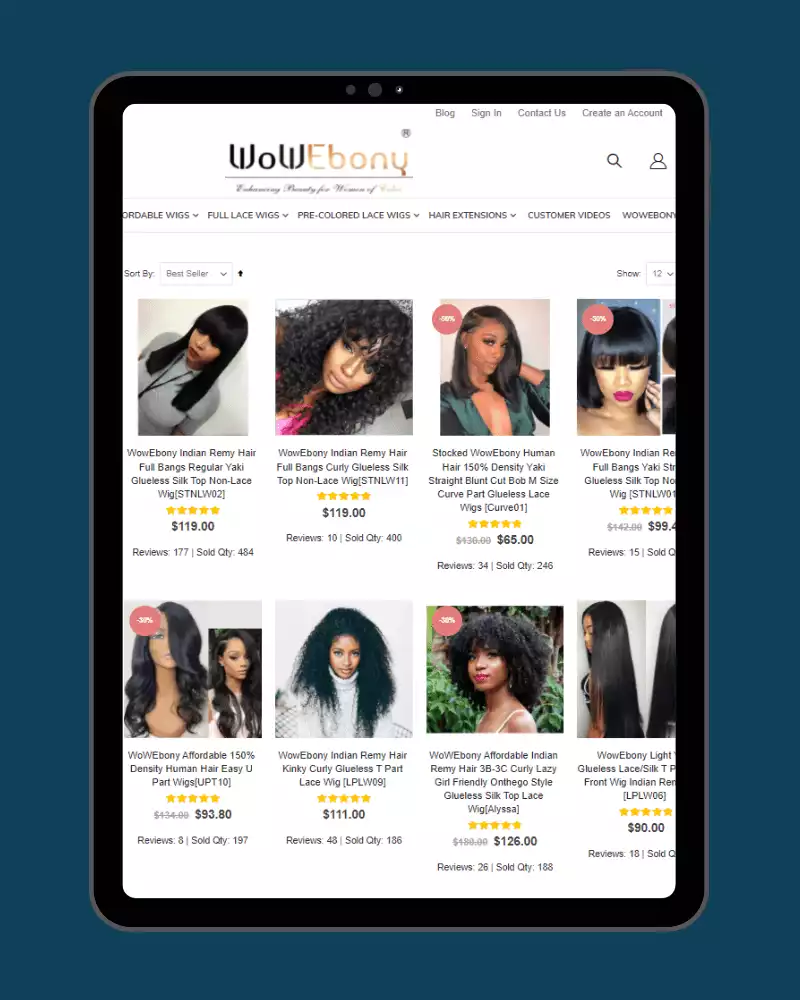Jump to:
In the market for a wig? If you want to choose the best option for your needs, start by gaining a better understanding of the different types of wigs that are available. And trust us — this guide is worth a read.
Why Does Wig Type Matter?
In this guide, we’re digging deep into the different types of wigs and how to choose the type that’s best for you. But why does wig type matter? Can’t you just choose a wig that looks pretty and be done with it?
Not if you want your wig to look natural and, erm, not artificially “wiggy.” Wigs can be constructed in a few different ways. The way a wig cap is constructed and designed affects:
- The overall shape of the hair
- The amount of coverage it offers
- The hairstyle options you’ll have when you wear it
And not all wig types will be suitable for your needs. The type of wig you choose is really important. It will determine how it’ll look on you, the hairstyles you can pull off while wearing it, how natural it appears, and how comfortable it is to wear.
Some types of wigs are best for women with thinning hair who just need a boost in fullness, volume, and perhaps length. Some are geared toward women who want to completely transform the appearance of their hair texture, length, color, or style. Other types of wigs are designed to look as natural as possible for different parting choices and hairstyle options.
Keep reading to learn about the different types of wigs, your wig hair fiber choices, and choosing a wig that offers the type of coverage and look you’re going for!
The 5 Types of Wigs

EKS Design/Shutterstock
If you’ve been browsing wigs online or thinking about buying one, you’ve probably noticed that there seem to be a lot of different wig types. When you browse a wig shop online and see dozens of wig categories (or more!), it’s easy to get overwhelmed and decide to hold off on your purchase until you have more time to do some research.
Well, consider it research time! We’ve simplified the wig categories into the 5 general types. If you can learn to identify each of these wig types and know the pros and cons of each, you’ll be able to choose the best type of wig for your needs.
The 5 general types of wigs are based on the materials and construction of the wig cap: Polyurethane, lace, monofilament, combination, and wefted (open cap) wigs. See the differences and features of each wig type below.
Lace Wigs (Full Lace and Lace Front)
Lace wigs are one of the most common choices of all the different wig types. These wigs feature a mesh “lace” base that is sheer to help it adapt to the color of your scalp when you wear it.
The wig’s hair fibers are tied individually to the sheer lace material for a more natural look that moves much like your natural hair. In lace wigs, you can choose from lace front wigs and full lace wigs.
Lace front wigs feature a basic wig cap with sheer lace in the front section – typically 1.5” to 3” of sheer lace around the forehead. Individual wig hair fibers are hand-tied to the lace section in front to create a natural, gradual hairline that doesn’t look heavy or artificial. Lace front wigs are great for women who like to wear their hair down and experiment with center and side parts without showing the edges of the wig.
Full lace wigs cost more than lace front wigs, but have the most natural look and versatility for styling. A full lace wig features sheer lace material over the entire wig base. This means you can part your hair in any direction or pull it up into a high ponytail without revealing the base of the wig. Full lace wigs are best for women who like to wear a large variety of hairstyles (up and down) and want the most natural appearance.
Pros
- Very natural appearance
- Allows you to part and style hair off the face due to natural hairline
- Makes high ponytails and updos possible (full lace)
- Lightweight, breathable, and comfortable wear
Cons
- More expensive than basic capless wigs
- Fragile lace material requires careful handling and maintenance
- Some lace wigs may require customization before wear
- Can be difficult to remove lace tape or adhesive residue
Monofilament Wigs
Monofilament wigs are similar to lace wigs, but there are some key differences. In monofilament wigs, every individual hair fiber is tied to the wig base to mimic the way hair naturally grows from the scalp.
Each hair fiber may be tied by hand (100% hand-tied), or the wig may feature a hand-tied top or crown area. Like lace wigs, the monofilament wig base material is thin, sheer, and gauze-like, but this wig type is much more durable than a lace base.
Since each hair fiber is hand-tied, there are generally fewer hairs attached to monofilament wigs than other types.
This is great if you’re looking to try sleek hairstyles with your wig, but not so great if you love voluminous, thick hairstyles. You can choose from single monofilament, double monofilament, or more affordable combination wigs with a monofilament top, crown, or part.
Single monofilament wigs feature hand-tied hair fibers throughout the wig to create a natural look with fibers that hang and move like your natural hair. These wigs allow you to part your hair anywhere on the head because they ensure natural-looking mesh “scalp skin” shows through wherever you part the wig.
Double monofilament wigs also feature hand-tied hair fibers for a natural appearance and allow you to part your hair anywhere on the head, but they have an additional layer of glass silk for an even more natural appearance. Glass silk is extra fine silk infused with polyurethane to mimic the appearance of scalp skin and create an additional layer of protection from the hand-tied knots in the wig. This makes double monofilament wigs perfect for anyone with a sensitive scalp.
Monofilament top, crown, and part wigs are considered combination wigs. We’ll talk more about these types of wigs in the next section.
Pros
- Very natural appearance
- Hand-tied hair fibers for realistic movement
- Part the hair anywhere without revealing wig base
- Additional protection for sensitive scalps
- Sturdy monofilament mesh is durable and long-lasting
- Lightweight, cool material for comfortable wear
Cons
- More expensive due to hand-tying process
- Thinner overall density and volume with fewer hair fibers
Combination Wigs
Combination wigs feature machine-sewn wefts (sections or strips of wig hair fibers) in combination with strategically-placed hand-tied hair fibers for a more affordable alternative to 100% hand-tied wigs.
Combination wigs use machine-sewn wefts to fill most of the space on the less-visible back and sides of the wig. Only the most visible areas – usually the top, crown, or sections along common part lines – are hand-tied to give that natural look and effect.
With fewer hand-tied fibers in the wig, the manufacturing process is less time-consuming and labor-intensive for a combination wig versus a full monofilament wig. This makes combination wigs a more affordable alternative to monofilament wigs, but you still get the benefit of a natural-looking part and realistic hair movement.
Unlike a 100% hand-tied monofilament wig, combination wigs are not suited for updo hairstyles because they don’t feature hand-tied hair fibers in the back and sides. The machine-sewn weft strips in those areas look fine when the hair is down, but would make your wig obvious if the hair was worn up.
Monofilament top wigs feature a section of hand-tied hair fibers that extends over the entire top of the head. The back and sides are filled in with machine-sewn wefts. This is the most versatile type of combination monofilament wig because you can do some half-updo styles without revealing the wig base.
Monofilament crown wigs feature a section over the crown with hand-tied hair fibers for a more natural appearance. The rest of the wig is filled in with machine-sewn wefts. The hair fibers in the crown section will have more realistic movement and will lay more naturally for a less artificial appearance.
Pros
- More affordable alternative to 100% hand-tied wigs
- Benefits of monofilament wigs without high cost
- Somewhat lightweight and breathable
Cons
- Less natural appearance than 100% hand-tied wigs
- Not updo or ponytail-friendly
Capless Wigs
Capless wigs, also called wefted, open-cap, or open weft wigs, are basic wigs that feature machine-sewn wefts (strips of attached hair fibers) attached to a stretchy wig cap.
Since machine-sewn wefts don’t appear to “grow” naturally from the scalp like hand-tied hair fibers, capless wigs rely on the PermaTease process to create volume that disguises the wig cap at the crown and part areas. Capless wigs are very breathable because of the spaces between the elastic strips in the cap base.
They are the most affordable wig type, so this kind of wig is perfect for anyone on a tight budget. While affordability is the major draw for capless wigs, they don’t have much to offer in the natural appearance category.
The machine-sewn wefts can look somewhat realistic from a distance, but they won’t hold up to close scrutiny. This is because capless wigs don’t feature any type of mesh or lace material to mimic the natural scalp. And without hand-tied hair fibers, the pattern of weft strips in capless wigs is somewhat obvious when you take a close-up look.
Pros
- Very breathable and cooling
- Most affordable type of wig
- Durable and easy to care for
- Built-in PermaTease volume
Cons
- Least natural appearance of all wig types
- Can have artificial-looking volume and height
Polyurethane Thin Skin Wigs
Polyurethane wigs, also known as poly, thin skin, or PU skin wigs, are wigs with a polyurethane “scalp” base that is made to look like a natural scalp with hair growing through. The polyurethane material in this type of wig makes attachment with wig adhesive or tape much easier because it bonds well with these products.
But the material used in poly wigs isn’t as breathable as other wig materials. Many women who’ve tried PU skin wigs say they tend to feel hotter on the head than other types.
In addition, a polyurethane wig may not give you a 100% natural appearance when fitted over a full head of hair because it may appear to “float” over the scalp. Because the material doesn’t stretch, fitting is crucial when buying a poly wig.
Poly wigs are generally best for people experiencing full hair loss (due to different types of alopecia, medical treatment, or hormonal hair loss). Here’s a look at the pros and cons of choosing a thin skin wig.
Pros
- Match your scalp skin tone for a natural appearance
- Wig hair fibers appear to naturally “grow” from the scalp
- Securely attaches with or without the use of adhesive or wig tape
- Easy to clean and reuse
- Most natural-looking wig option for full hair loss
- Hair can be parted or pulled up without revealing wig
Cons
- Not as comfortable as other types of wigs
- Tend to feel hotter on the head due to poly material
- May look less natural when fitted over hair
- Pricier than other wig types
- Cap size and fitting is crucial due to no-stretch material
Types of Wig Hair Fibers

Tom Black Dragon/Shutterstock
Not only are there different types of wigs for you to choose from – there are also different types of wig hair fibers. Wig hair fibers can be real human hair, virgin human hair, remy human hair, synthetic hair, or heat-friendly synthetic hair. Learn more about each type of wig hair fiber below.
Human Hair Wigs
Human hair wigs feature real human hair from donors. Human hair is used to give wigs the most natural-looking appearance and make styling and care more similar to how you’d treat your own hair.
Human hair wigs cost more than wigs made with synthetic hair because donated human hair is much more limited in supply. Human hair wigs can be heat-styled just like natural hair.
You still need to use heat protectant to avoid damaging the hair in the wig! You can expect a real human hair wig to last about a year or more with proper maintenance and care.
Human hair that is not labeled as virgin may have already been chemically processed (colored, permed, or chemically treated prior to being attached to the wig), so it’s not recommended to color, perm, or chemically straighten a basic human hair wig.
Virgin Human Hair Wigs
Virgin human hair is more costly than basic human hair because it has never been chemically processed – either while on the donor’s head or during wig manufacturing. It’s harder to get virgin hair donations and supply is always limited, so this type of human hair costs more.
Virgin human hair is very high quality and is widely regarded as one of the best options for wigs. If you plan to chemically process your wig to make it more “you,” you’ll want to spring for a virgin human hair wig that won’t have already been damaged by chemicals.
Remy Human Hair Wigs
Remy human hair wigs are another option if you want the real deal. Remy hair is donated human hair that has been collected in a bundle with all hair fibers running the same direction. This is done by securing the hair with an elastic band before cutting off the hair to be donated.
By keeping the hair bundled and contained before cutting, the hair fibers stay pointed in the same direction – which is what remy hair is all about.
When all the fibers run the same way, the hair looks shinier, smoother, and more natural. It’s also softer and less likely to tangle. For these combined reasons, real remy hair lasts the longest of any wig hair fiber – up to 2 years. Remy hair is pricier than basic human hair, and virgin remy hair is the most expensive form of human hair for wigs.
Synthetic Hair Wigs
Synthetic hair fibers are used to create more affordable wigs that feel and look similar to real human hair. The appearance and texture isn’t perfect, but many high-quality wigs with synthetic hair fibers do a great job creating a close approximation of human hair.
Basic synthetic wig hair is not heat-friendly. The synthetic material will melt if exposed to high heat. This means you can’t style it with hot tools – no flat irons, curling irons, curling wands, or hair dryers. Synthetic wigs are often pre-styled, so as long as you can properly store and care for the wig, you can expect it to last about 4-6 months.
Heat-Friendly Synthetic Hair Wigs
Heat-friendly synthetic wig hair is a better option for most women looking for affordable synthetic wig options. This special hair fiber is able to withstand the heat from hair dryers, curling irons, and flat irons to give you more style options.
However, each time you use a hot tool on heat-friendly synthetic hair, it loses a little more of its durability. You can expect heat-friendly synthetic hair to last 2-3 months or less if you heat style daily.
Where to Buy Wigs Online

Now that you’ve looked at the 5 different types of wigs (lace, monofilament, combination, capless, and polyurethane) and the types of wig hair fibers you can choose from, you’re probably feeling more prepared to buy a wig that will suit your needs.
The only problem? There are millions of online wig retailers to choose from. That alone is overwhelming for a wig newbie, and to make matters worse, many of these online wig shops are selling subpar, cheap wigs that aren’t even fit for Halloween.
So where can you buy a wig online that you can be sure you’ll love?
We partnered with WowEbony to bring you the best selection of wigs online. We think there's no comparison.
Dolago is always our top recommendation for women looking for quality, durable wigs that don’t look fake or over the top. No other online wig retailer offers wigs of this quality for such an amazing value.
They offer a range of wig types – lace, monofilament, combination, capless, and polyurethane – at different price points so there’s genuinely something there for anyone’s budget.
You can pick from the highest quality synthetic hair to virgin human hair. Check out Dolago to take advantage of all they have to offer, including:
- Fast, free shipping on every order with no minimum
- 100% virgin human hair wigs that can be heat-styled and chemically processed
- Free exchanges within 30 days and full refunds if your wig isn’t what you wanted
- Safe, secure payment options from credit cards to PayPal
- Reward points for signing up and every purchase you make
You can shop guilt-free because you’ll earn reward points with every single purchase. And right now, they’re running some incredible promos with serious discounts on their most popular wigs and extensions.
Now that you know about the different types of wigs and where to buy them, how about a little homework to complete? Learn more about where to buy wigs online here: Where to Buy Good Wigs Online.
Looking for info on wigs for women of color? Check out our complete guide here: The Complete Beginner’s Guide to Wigs for Black Women. Look for the surprise promo codes on each guide to save big on your next wig!

